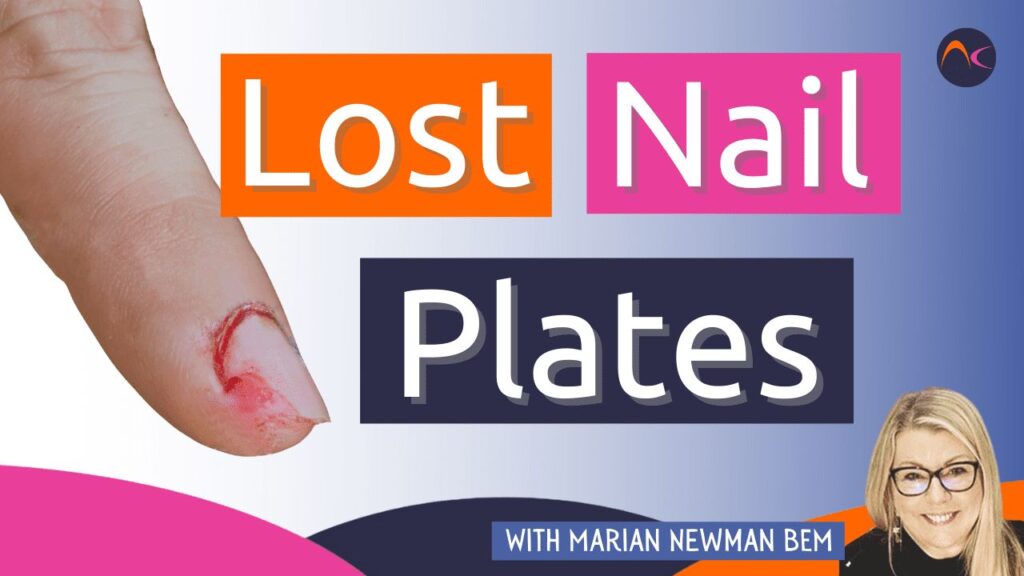Ha habido muchas imágenes espantosas de placas de uñas arrancadas del lecho ungueal debido a accidentes mientras se llevaban recubrimientos o mejoras.
This used to be a fairly frequent event many years ago when MMA was the main monomer used in an L&P system, but it shouldn’t be the case now! So, what is happening? How can it be prevented?
MMA (methyl methacrylate) is not any more hazardous than the far more common EMA (ethyl methacrylate) but it is inappropriate for nail overlays and enhancements. One of the reasons for this is it is too hard and inflexible. Its adhesion to the nail plate is also very strong as it mostly uses a physical bond to the nail plate which, basically, needs to be shredded for the bond to work.
This meant that if there was accidental damage to the nail the overlay wouldn’t break but the nail plate would be ripped off!! OUCH!!! Very painful, open to infection and months to heal and grow back.
EMA as a monomer, is much more flexible and the nail plate does not need to be shredded and therefore severely weakened. With the correct application, i.e., correct ratio and structure, the overlay or enhancement will break before the nail plate is ripped off.
The same is true for any type of coating, overlay or enhancement. Adhesion and strength needs to be good for longevity but not put the whole nail plate at risk of this dreadful result, that can occur with minimal pressure.
Accidental damage can still be painful as the break can be over the hyponychium and can draw blood but, it is where a natural nail can break with enough force. When this happens, all the bodies protection systems come into play. The blood will clot and help seal the area; antibodies will help protect against infection. The pain will be short lived, and all will heal very quickly. A break lower down on the nail bed or a nail plate ripping off is far more serious!
The natural nail flexes all the time. Using your hands or just walking for toe nails, means that the nails move along with the fingers or toes. If the flexibility of the overlay is much less than the nail plate, then the ‘best’ scenario is that the overlay will be pulled apart from the nail plate causing lifting anywhere on the nail. The worst scenario is the loss of a nail plate.
¿Cuál es la causa de estas roturas? Pues muchas cosas:
- Recubrimiento demasiado grueso. Si el revestimiento, recubrimiento o mejora es demasiado grueso, es decir, el espesor es más fuerte que la placa de clavos, la placa de clavos se arrancará primero.
- Utilizar un producto que no está formulado para ser flexible
- La proporción errónea de un sistema L&P
- Too much buffing of the nail plate so it becomes weakened and can easily ‘pop off’ the nail bed
- Permitir que los clientes pasen demasiado tiempo entre servicios para que la estructura de la mejora o recubrimiento se mueva a un lugar que comprometa la placa de la uña.
- This can happen with a UV gel polish especially if a ‘builder’ has been used and the service time is too long
¿Cómo puede evitarse?
- Utilice productos de buena calidad que sean flexibles
- Utilizar la proporción correcta para un sistema L&P
- Estructurar correctamente el revestimiento o la mejora
- No aplique NINGÚN sistema demasiado grueso para la placa de la uña que hay debajo
- No pulir continuamente la placa de la uña para debilitarla
- Asegúrese de que las citas son apropiadas, es decir, no más de 3-4 semanas como máximo.
If a nail plate is ripped off while wearing a coating, overlay or enhancement this is the fault of the nail professional!!! An overlay or enhancement should ALWAYS break before the nail plate is ripped off.
Qué hacer si esto ocurre:
- No se puede adherir una uña nueva a un lecho ungueal expuesto
- Un lecho ungueal expuesto necesita cicatrizar y crecer una nueva uña
- There are some products that are formulated for this service BUT there is always the chance that a client can develop an allergic reaction to these being applied to the open nail bed. This is where careful consultation and advanced education is needed.


